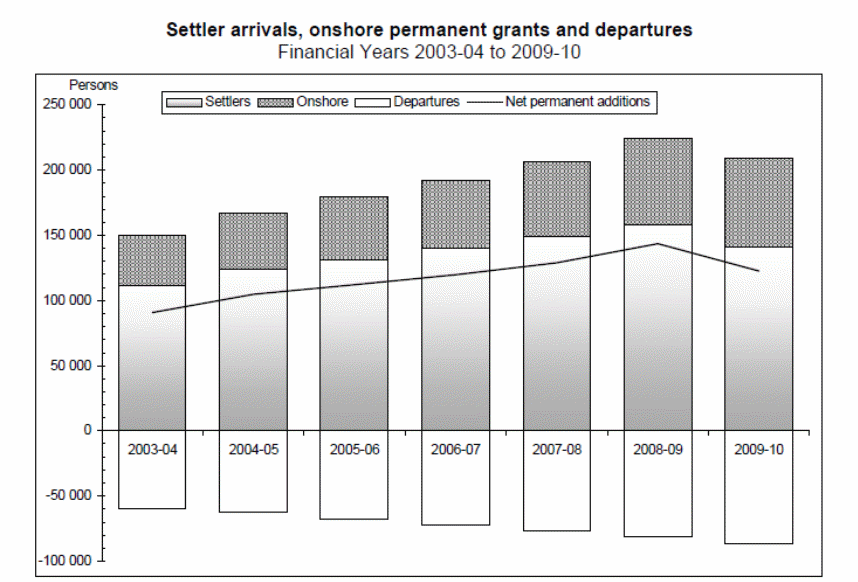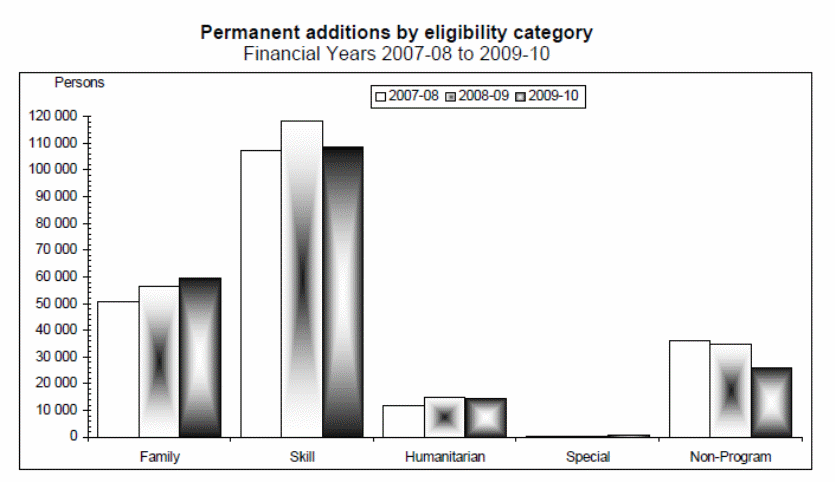Introduction
Since the establishment of the Australian federal department of immigration in 1945, over 6 million migrants, including more than 600, 000 refugees have been reported to be residing in Australia. The identity and nationality of the Australian migrants have changed from the traditional United Kingdom and European nations to Middle East and Asia.
According the Parliament of Australia (2006), 24% of the current Australian population is made up of individuals born overseas, and 40% of the total population has one or both parents born out of Australia.
In addition, the current Australian population is made up of almost 185 countries and more than 200 languages spoken within its borders. In the last few years, the Australian government has been greatly anxious about the increasing number of immigrants from the Middle East (Kippen & McDonald, 2000, 34).

Source: Adapted from Australian Government: Department of Immigration and Citizenship.
Of particular concern to the Australian is the fact that most of these people are illegal immigrants. While the treatment of the Middle East immigrants by the Australians has been heavily criticism internationally, of particular concern to scholars has been how this particular group of immigrants to Australia considers nationalism and ethnic identity in Australia.
The objective of this essay is to provide an overview of the what Australian nationalism and identity means to the Middle East immigrants in Australia
Nationalism and Identity among Middle East Immigrants to Australia
According to Walsh (2001, 56), nationalism exemplifies the good qualities of patriotism; however, it is comprises of different characters. Kippen and McDonald (2000, 34) argues that nationalism is the way a particular group of people think about their nationhood and how they promote the interest of their nation.
In this sense, nationalists would promote economic, political, cultural and legal independence of their country (Kippen & McDonald, 2000, 33). It is on this basis that the Australians have constantly viewed immigrants to their country not only as people who have no entitlement to reside within the country’s borders but as individuals out to stifle any form of independence in the nation.
The controversy surrounding treatment of immigrants especially those from the Middle East has always been informed by the argument that Australia is a country with a common culture and race, hence illegal immigrants have no entitlement whatsoever to live in the Australian community (Walsh, 2001, 78).
Despite these arguments and continued detention of illegal immigrants (also termed as boat people in reference to their means of transport into the country), the immigrants from the middle east have continuously flocked the country since the abolition of the Dictation Test in late 1950s.
According to Walsh (2001, 67), 77 per cent of the total number of third-world immigrants to Australia are of Asian origin. Why the Middle East immigrants in Australian have found it easier to adapt to the Australian nationalism and identity as oppose to English-speaking white immigrants has been greatly debated in various literatures on Australian nationalism and immigrant populations.
Kippen and McDonald (2000, 33) argues that despite the recent controversies related to the native Australians growing anxieties about middle east immigrants, this group of immigrants have always valued Australian citizenship more than immigrants from Britain and other English speaking countries.
Since 1950s, Australia has greatly transformed its population from a predominantly white to a multicultural society consisting of diverse cultural groups from all corners of the globe. This change had begun in the 1950s when the Australian government started to relax some of its ‘White Policies’ that had become the hallmark of the post-independence Australia (Walsh, 2001, 89).
In the subsequent decades, the country experienced increased number of immigrants from different cultural and racial backgrounds, majority of whom originated from Asia. The country signed a migration agreement with Turkey, a non-European, which allowed immigrants from Turkey to be easily assimilated into the Australian nationalism (Kippen & McDonald, 2000, 33).
When the country elected the first Labor government in 1972 since 1948, radical changes were implemented by the immigration ministry to make Australia more receptive to multicultural immigrants flocking the country (Walsh, 2001, 34). The changes brought an end to the quota system whereby immigrants were determined by their country of origin in order to preserve the Australian homogeneity.
The Labor government through its Minister for Immigration, Al Grassby, declared the country a multicultural society and affirmed that previous ethnic and/or racial discrimination inherent in the post-independence Australia had been permanently eliminated in the Australian society (Kippen & McDonald, 2000, 33).
Middle East Immigrants
The development in the early 1970s led to influx of migrants into Australia in a way never witnessed before. The migrants were particularly migrating from Middle East. For instance, a huge contingent of migrants in boats reached Darwin in 1975. According to Walsh (2001, 67), over 25,000 people from East Timor, China, Vietnam and Middle East have since migrated to Australia in the last thirty years.
However, majority of Asian immigrants to Australia in recent years have been from the Middle East (Naidoo, 2007, 23). Despite declaring the country a multicultural society, the Labor government as well as subsequent governments have continuously subjected the Middle East immigrants to compulsory detention during which the government would assessed their refugee status claims (Kippen & McDonald, 2000, 23).
Although the interment policy has drawn much criticism from both the Amnesty International and the United Nations, the Australian governments have never relented on this policy.
However, what astounds both Australians and scholars alike is the ease with which the Middle East immigrants have integrated into the Australian national and cultural identity. Even after undergoing inhumane treatments in the hands of Australians, the Middle East immigrants have continuously found it easier to identify with the Australian nationalism and cultural identity.
Fitzgerald Inquiry
The changes to the Australian immigration policies implemented in 1988 after the Fitzgerald Inquiry further encouraged migrants from the Middle East to entrench their foothold in Australia. Following the inquiry, the Australian government changed its migration policy from an emphasis on ‘family reunion’ to one stressing business and skilled categories of migrants (Walsh, 2001, 87).
Assisted passage into the country had been stopped in early 1980s and only those ascertained to be refugees were accorded support upon arriving in the country. This was followed by increased number of illegal immigrants from Middle East claiming to be refugees with the hope of gaining entry into the Australian community (Kippen & McDonald, 2000, 54).
Naidoo (2007, 12) observes that for the first time in the migration history of Australia, the number of immigrants arriving from Britain dropped drastically below that of Asian immigrants.
This was explained by the renewed prosperity that was sweeping across Europe at the time. while in the earlier decades the British, Italian and Greek immigrants were the majority of populations migrating to Australia, migrants from China, India and other middle east countries would fill the vacuum vacated by the reduced influx from Europe (Naidoo, 2007, 14).
Numerous conflicts in the Middle East region also meant that there was increased migration from the Middle East. Australia provided safe haven for this group of people who were flocking the country in the 1990s and early 21st century as intra and inter-state wars escalated.
The Impact of Major Wars and Historical Events
For most communities migrating from the Middle East to Australia, major wars and historical events have been the influencing factors. According to Naidoo (2007, 15), the large scale movement of middle immigrants has been a recent phenomenon influenced by protracted conflicts between Arabs and Israelis, the Gulf war, 15 years of civil war in Lebanon and the emergence of Islamic fundamentalist groups.

It is against this backdrop that the Middle East immigrants have been attracted by the social, political and economic opportunities offered by the Australian immigration policies and programs (Walsh, 2001, 45).
Cronulla Riots in Sydney in 2005
Despite this increased influx of migrants from the Middle East as well as the immigrants’ easier integration, the issue of nationalism and identity has brought a number of conflicts and disharmony between the native Australians and the Middle East immigrants. Naidoo (2007, 23) recalls the Cronulla Riots in Sydney in 2005 which was ethnically motivated.
In a series of mob confrontations, the riots involved a group of individuals claiming Anglo ethnicity who felt that Australia should not be opened to other ethnic groups especially those from the Middle East. In effect, despite the Australian government’s immigration policy allowing for multicultural integration, migrants within the country’s borders have always erected barriers between their different ethnic groups.
While the Cronulla riots erupted after a number of youths of Anglo descent were attacked by another group claiming Middle East ethnicity, the conflicts between Middle East immigrants have always been motivated by some underlying factors (Naidoo, 2007, 23).
European View with Regard to Nationalism and Identity
According to Naidoo (2007, 16), the Australian communities of European origin have always tried to portray the Middle East immigrants as ‘others’. Although the division along ethnic and racial lines have always been there, the portrayal of Middle Easterners as “others’ was more intense after the September 11 attacks in the united states (Walsh, 2007, 65).
Consequently, this has led to erection of barriers between ethnic identities especially between those from the Middle East and those of European decency. Naidoo (2007, 12) observes that while ethnic identity has always informed the conflict between these groups of immigrants, national dominance and nationalism have been the most underlying reasons for these conflicts.
According to Walsh (2001, 67), groups of people within a multicultural society would always mobilize around ethnic and religious groupings in order to attain or claim national dominance through state power. Just like other immigrants in Australia, Middle East immigrants are rightfully exercising their own identity in order to claim a stake in the country’s nationalism.
Conclusion
In exploring the understanding of Australian nationalism and identities, the Middle East immigrants have by far been able to integrate into the Australian multicultural society, albeit with some difficulties. In the last few years, the Australian government as well as the majority white Australian communities has been greatly anxious about the increasing number of immigrants from the Middle East.
Of particular concern to the Australian is the fact that most of these people are illegal immigrants, who, based on their identity pose a great threat to Australian nationalism.
Consequently, this categorization of the Middle East immigrants has led to heightened ethnic competition between different ethnic identities in the country’s multicultural society. However, the competition between different ethnic groups has ushered in a different dimension in the Australian multicultural society whereby every ethnic identity seeks to have a stake in the country’s nationalism.
References
Kippen, P. & McDonald, P. (2000). Australia’s population in 2000: the way we are and the ways we might have been, People and Place.
Naidoo, L. (2007). Rupture or continuity? The impact of globalization on cultural identity and education in Indian immigrant families in Australia. Transnational Curriculum Inquiry, 4 (1).
Parliament of Australia, (2006). Australia’s settlement services for refugees and migrants, E-Brief: Online Only issue 9. Web.
Walsh, Kate. (2001). The changing face of Australia: A century of immigration 1901-2000, Sydney: Allen & Unwin.